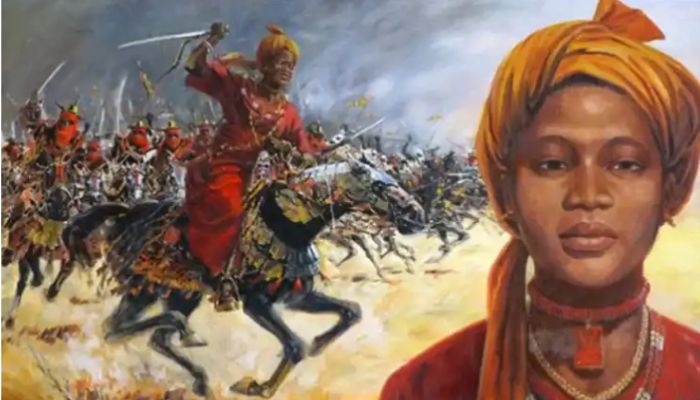Africa’s history will not be complete without the mention of its great kings and queens. These monarchs have played important roles in Africa’s history, from political, economic, and infrastructural reforms. Sadly, most of these kings and queens have been outshined by modern-day leaders, and most Africans do not even know such great leaders ever lived.
In this article, we will be looking at 20 of the greatest African kings and queens who have ruled different parts of Africa and how their reigns impacted the territories they ruled over.
Great Kings And Queens Of Africa
1. Pharaoh Akhenaten
Although Egyptologists know very little about Akhenaten’s birthday and early life, it has been established that he was named Amenhotep at birth. Akhenaten was the son of Pharoah Amenhotep III of Egypt and his wife, Tiye and he became heir to the throne after his older brother, Thutmose died.
He ruled as Amenhotep IV until the 5th year of his reign when he changed his name to Akhenaten. Also, Akhenaten was married to Queen Nefertiti and other women, who bore him many children.
This king is famous for abandoning Egypt’s traditional polytheism and introducing a new religion known as Atenism. This religion was centered on worshiping a god called Aten, which was represented as a solar disk. Consequently, he attacked other Egyptian gods and erased the names and images from Egyptian monuments.
He also created new architectural designs and moved the capital city of Eygpt to a new site named Akhetaten. This translates to “a place where Aten becomes effective”. He further claimed that Aten manifested itself for the first time there.
Akhenaten died in the 17th year of his reign. However, the reason for his death and where he was buried have remained a mystery. It was also revealed that he was not given a royal burial.
2. Queen Amina

Also called Aminatu, Queen Amina was born to King Nikatau, the 22nd King of Zazzau, and his wife, Queen Bakwa Turunku, in the mid-16th century.
After the death of her father, her older brother, Karami, became king. During his reign, Amina led the cavalry of her Zazzau’s army and became a famous warrior princess. Subsequently, after the death of her brother in 1576, she ascended the throne of Zazzau.
During her reign as the Queen, she conquered many territories which led to the expansion of the kingdom. It was said that she built walls around all the areas she conquered, which was proof of her existence. Similarly, she introduced the production of kola nuts in the area.
Although there are plenty of discrepancies surrounding her death, many authors have stated in their writings that she passed away in Atagara, which is the modern-day Idah, Kogi State of north-central Nigeria.
The Queen exceeded the accomplishments of her predecessors. Although she did not get married, it was revealed that she took slave husbands from villages she conquered and executed them afterward. In recent times, the matriarch is a symbol of the strength of a woman.
3. Menelik II
Menelik II, one of the greatest African kings, was born in 1844, in Ankober, Shewa, Ethiopia. His father, Haile Malakot, was the king of Shewa. Menelik II got baptized and took the name Sahle Mariam.
Shortly before the death of his father, Menelik was taken as a prisoner by Emperor Tewodros II. While in captivity, he continued to receive an education and would later marry one of the Emperor’s daughters.
He escaped captivity and returned to Shewa and claimed his throne as the king in 1865. However, he had a bigger ambition, which was to become the emperor of the entire Ethiopia and not just a small village. In order to achieve that, he pledged his loyalty to Emperor Yohanes IV.
Menelik was the strongest contender for the throne after the emperor died in a battle. He was crowned “negus negast” which means king of kings, on November 3, 1889, at the church of Mary, on Mount Entoto
He transformed the Ethiopian empire and defeated the Italian troops to defend the independence of his people during his reign. Subsequently, he introduced a national currency, improved the educational sector, constructed a railway from Djibouti to the new Ethiopian capital, Adis Ababa, and established the first telephone and telegraph systems in the Empire.
The emperor suffered a stroke in 1909, after which his wife, Queen Taytu, ascended the throne. Unfortunately, the Emperor did not recover, as he died a few years later, on December 12, 1913. He was buried without any announcement or ceremony in the Imperial Palace. In 1916, he was reburied in a Ba’eta Le Mariam Monastery, Adis Ababa, which was specifically for him.
4. Kadanke Amanirenas
Also known as the “one-eyed queen”, Amanirenas was born between 60 and 50 BCE. She ruled the Ancient Kingdom of Kush between 40-10 BCE and is the second of the 8 Kandankes of the Kingdom of Kush.
Amanirenas is famous for defending her kingdom against the Roman Empire. She defaced the statue of Ceasar Augustus by removing its head and burying it at the entrance of her palace.
The Kadane was not intimidated by the weapons the Romans had, she gave the Roman Emperor, Augustus, an ultimatum. She sent him arrows with the message “If you want peace, they are a token of warmth and friendship. If you want war, you’ll need them”.
Augustus submitted to the demand of the queen even though he considered her message to be an insult. He withdrew Roman control from all the Kushite territories that had been conquered. The two empires signed a peace treaty in 22 BCE. Amanirenas died in 10 BCE.
5. Oba Oduduwa
Oduduwa is revered by the Yoruba people of West Africa not just as a ruler, but as a god. He is believed to be the founder of this widespread ethnic group. While some believed that he came to earth through a mythical chain in the 12th century and settled in Ile Ife, others believed he was sent by Olodumare, the lord of the skies, to fulfill a mission his brother, Obatala was unable to complete.
His name Oduduwa translates to “the great repository which brings forth existence”. He was the Olofin of Ile Ife and ruled the city for a few years. However, he never bore the title of the Ooni of Ife nor used the Ife traditional crown.
Unfortunately, Oduduwa was killed during a leadership contest between Obatala, Orunmila, and Owa Ilare. His death led to the dispersal of his children and grandchildren to different territories where they became founders. One of these territories is the great Benin Empire founded by his grandson, Prince Oranmiyan. Another of his grandsons became the first Alaafin of Oyo.
In the Yoruba culture, Oduduwa is a symbol of life or the power of the womb. He also represents the omnipotence and the values of the culture.
6. Makeda
The Queen of Sheba is one of the queens recorded in the Bible. She was also known as Queen Sheba, Queen of Saba, and Queen Belqis. She became the Queen of Axum after winning the battle against the serpent king, Arwe, who had troubled the northern Ethiopian Kingdom.
Queen Makeda of Sheba was one of the women of Solomon, King of Isreal’s life. It was recorded that she traveled all the way to bring gifts to King Solomon. Afterward, she bore him a son, Menelik I, who would become the first imperial leader of Ethiopia and the first of the lineage of Aksumite kings.
Although her existence is disputed among historians, she is identified by modern historians with the Kingdom of Saudi Arabia. She is believed to be the first African Queen to rule in 960 BC, and through her, a lineage of East African and Nubian Kings emerged.
7. Mansa Musa
Mansa Musa is arguably one of the greatest kings to have ruled Africa. He ruled the Mali Kingdom from 1312 to 1337. His territory cut across present-day Mali, Nigeria, Senegal, Chad, The Gambia, Niger, Guinea, Mauritania, and Burkina Faso.
The already flourishing Mali Kingdom blossomed even more during his reign. At the empire’s peak, Mansa became the wealthiest man to have ever lived.
His wealth and greatness were recorded by the Europeans and the Egyptians. He built the economy of the empire by trading in gold, salt, and ivory among other things. With the money he got from trading, Mansa Musa funded the education, architectural, and art sectors of the Mali Empire.
The great King Mansa died in 1337 and was succeeded by his son, who could not handle the great empire left in his care. That led to the fall of the Great Mali Empire.
8. Yaa Asantewaa
This African Queen was born to Kwaku Ampoma and Ata Po, in Besease, in 1840. She was known as an intellectual, activist, and queen mother.
Yaa Asantewaa fought alongside her people against British colonialism in 1900. The war is also known as the Yaa Asantewaa War of Independence.
Sadly, she died after being exiled to Seychelles in 1921. She was considered a hero for not giving up the royal golden stool, which symbolizes the authority of the King, the soul of the nation, and the unity of the Asante people.
She is remembered for her active participation in the liberation of her people, which led to the territory becoming the first African nation in sub-Saharan Africa to gain independence from British colonialism.
9. Shaka Zulu
The founder of the Zulu empire was born to the chief of Zulu sometime in 1787. There were many controversies surrounding his birth because at the time, his parents were not married and their relationship was considered an abomination.
The complexities of their relationship led to his father denying the paternity but later accepting it. When Shaka was 6, his parents separated and he grew up with his mother; making him experience a terrible childhood. He was always referred to as a bastard. However, he did not allow the unfortunate events in his life to deter him.
He learned under the mentorship of the leader of another clan, Dingiswayo, whom he served. Digiswayo helped him take over the throne of Zulu from his brother in a coup, after the death of his father.
His reign was characterized by brutality and military expansion. After the death of Dingiswayo, Shaka Zulu took control of the surrounding territories and became the most powerful and influential ruler in the area. This led to the formation of the Zulu Kingdom.
After the death of his mother, he ordered that no crops should be planted for a year. Similarly, no milk should be used for the year, he also ordered the execution of pregnant women in the area. He murdered as many as 7000 people as a way of grieving. This led to his assassination by his half-brothers in 1828. He was buried in an unmarked grave
See Also: Greatest African Kings: Ewuare the Great
10. Queen Nefertiti
Nefertiti whose name means “a beautiful woman has come”, was the wife of Akhenaten, the Pharoah of Egypt. According to some sources, she is the daughter or niece of a high chief called Ay, from a town called Akhmim. Other sources suggest she was a princess of the Mittani Kingdom in Syria.
She ruled Eygpt alongside her husband and subsequently, after his death. She became very wealthy as she saw the expansions of the kingdom. The Queen changed her name to Neferneferuaten-Nefertiti which means “beautiful are the beauties of Aten, a beautiful woman has come”.
During her reign as Queen, she consolidated the developments made by her husband.
Today, Nefertiti is the ideal symbol of beauty and feminine power. The bust of Nefertiti is one of the icons of Ancient Egypt. She was known for many titles, some of which include Hereditary Princess, Great of Praises, Lady of Grace, Sweet of Love, Main King’s Wife, and Lady of all Women.




















